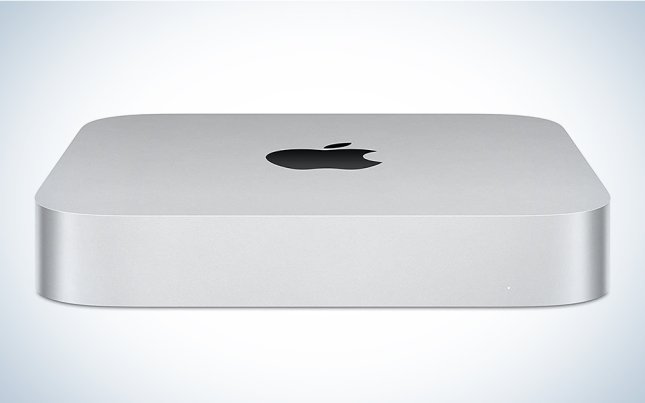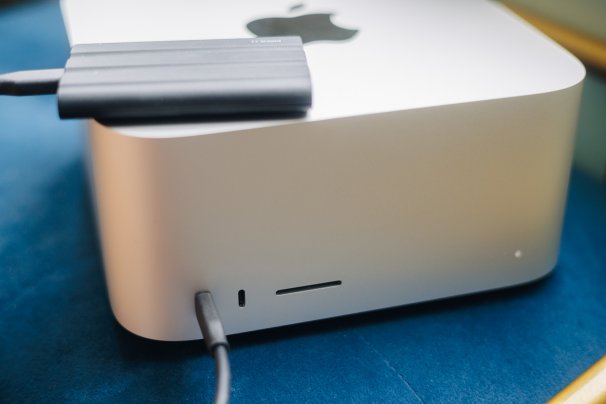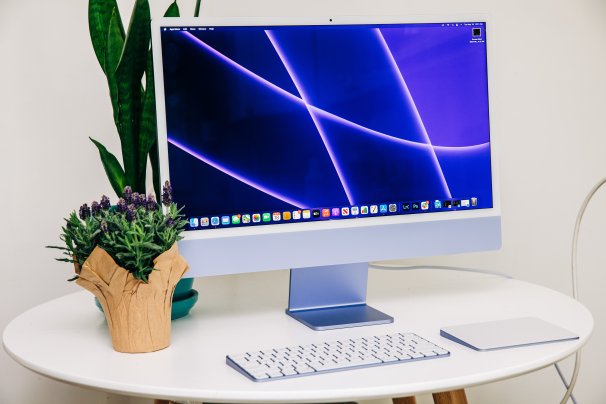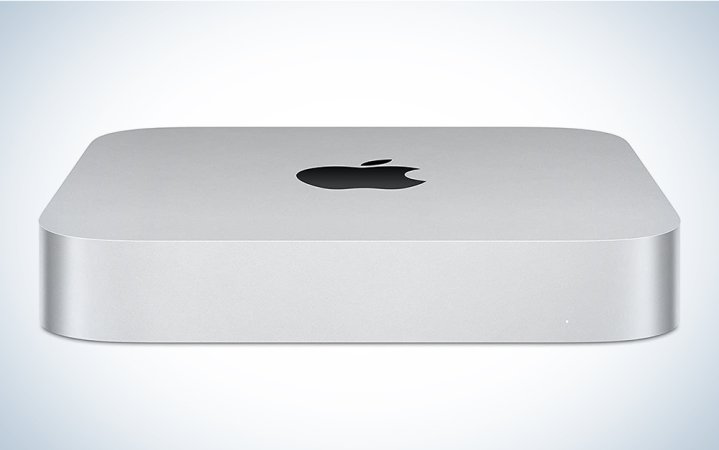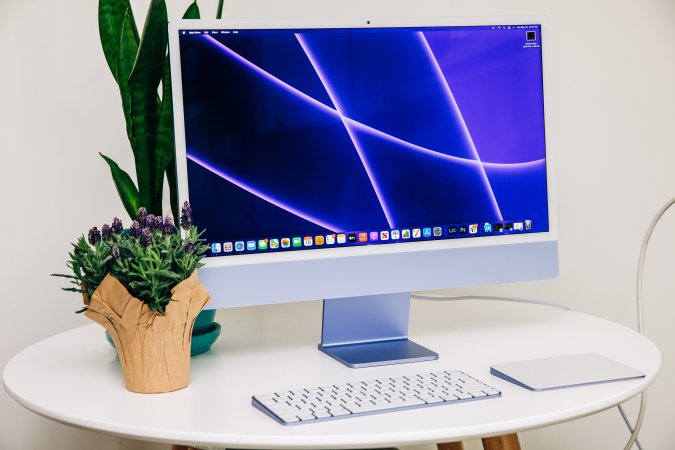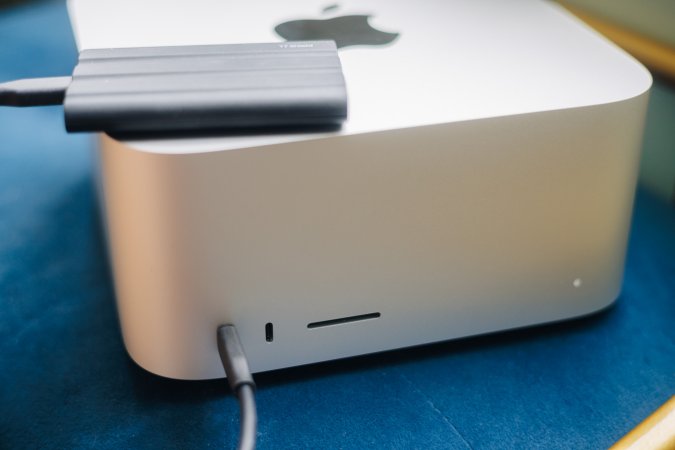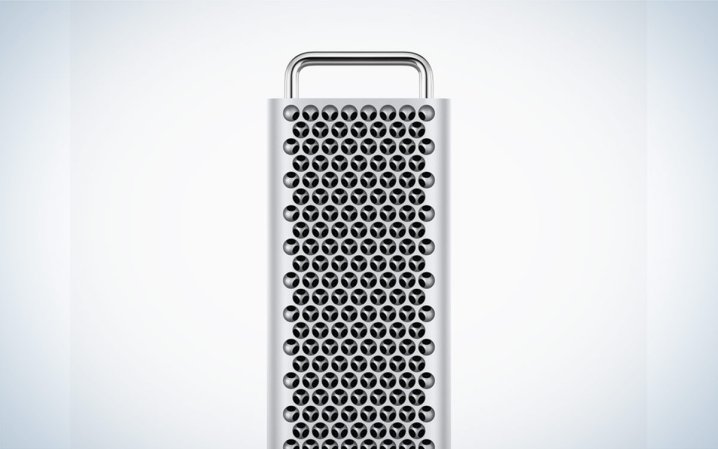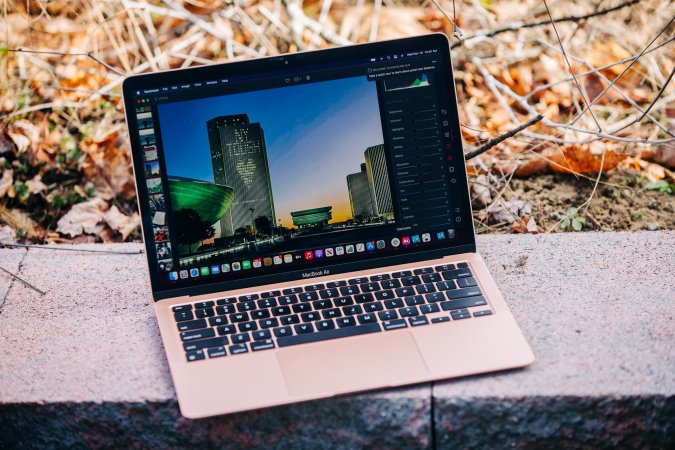We may earn revenue from the products available on this page and participate in affiliate programs. Learn more ›
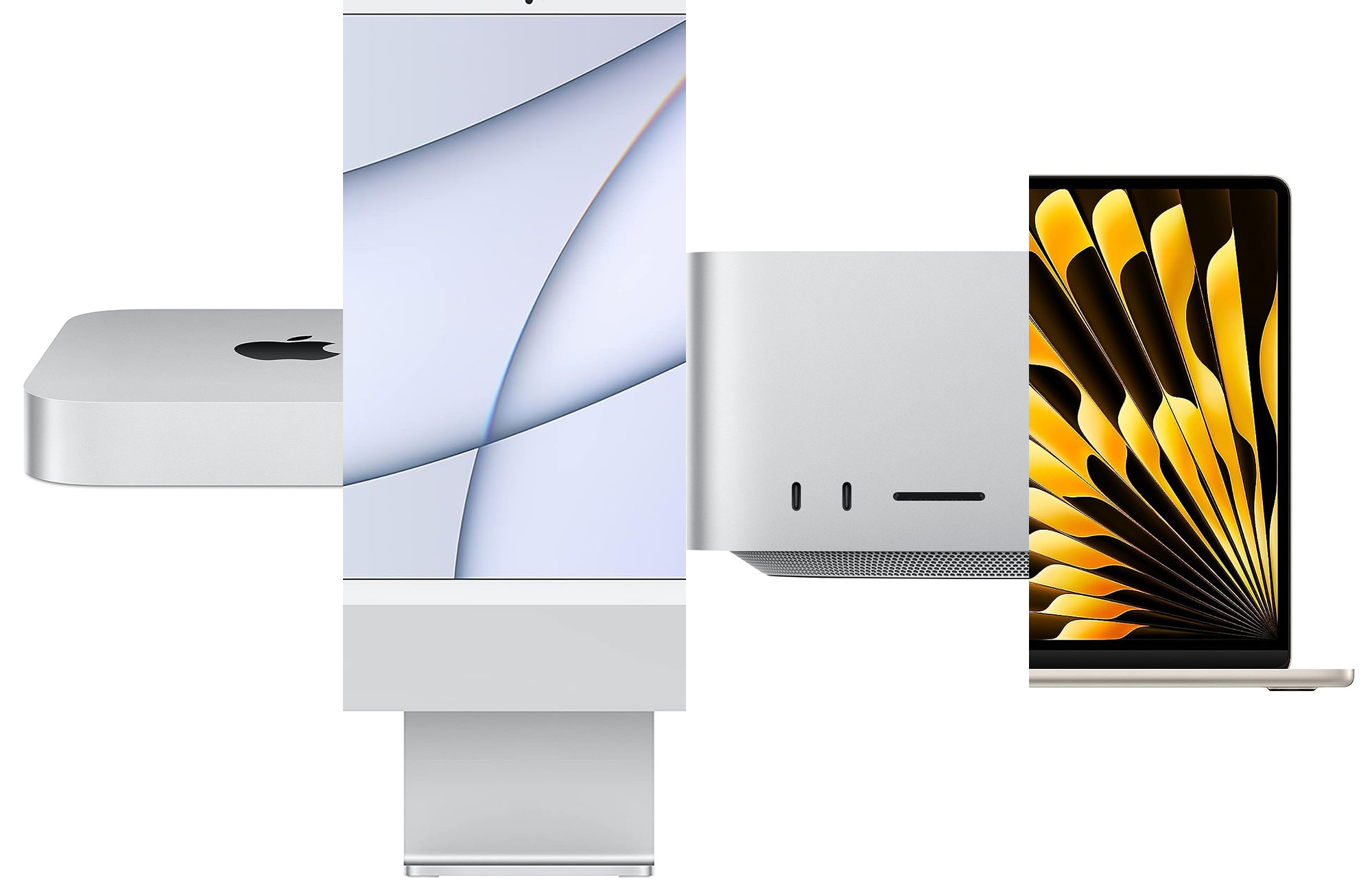
Just about every type of workplace has adopted Macs for business purposes at some point in their history. Macs have occupied the newsrooms I’ve worked in since my journalism career began. At first, they were exclusively for the photography staff, the graphic design team, the videographers, and the other content creators. But over time, perhaps because the IT team preferred to maintain just one operating system or maybe it was the ubiquity of the iPhone, the Excel-loving, word-processing staff also got issued Apple computers. Easy-to-use interfaces, reliability, and premium design aesthetic earned Apple praise, but higher price tags can often be a hurdle to widespread workplace adoption. We’ve compared Apples to Apples to unearth the best Macs for business regardless of the workload.
- Best overall desktop: Mac mini M2
- Best all-in-one: iMac M1
- Best desktop for designers and programmers: Mac Studio M2 Max
- Most powerful Mac: Mac Pro
- Best overall laptop: MacBook Air 15-inch M2
- Best budget laptop: MacBook Air 13-inch M1
How we choose the best Macs for business
Apple’s Mac options include the Air and Pro lines of laptops, plus the iMac, mini, Studio, and Pro lines of desktops—all with a dizzying amount of upgrade options. In addition to using Macs in our workplaces for decades, we pulled from extensive research and PopSci testing and reviews to decide on what’s best. Apple’s lineup isn’t huge, but the company has done a good job addressing specific areas of the market, sometimes with more than one appropriate option.
The best Macs for business: Reviews & Recommendations
Choosing Apple computers for the workplace is an investment—after all, Macs aren’t cheap. Some of those dollars go to the brand name, the easily recognized design aesthetic, and aluminum bodies instead of the much more prevalent plastic. Apple also packs each Mac with plenty of business-friendly features like biometric authentication, mobile device management, malware detection, and antivirus tools. Apple also controls the hardware and software, allowing additional security features to authenticate devices and seamless handoff when using an iPhone or an iPad to work on documents. This roundup matches the right processing power with the right job duties.
Best overall desktop: Mac Mini M2
Mac Mini M2
Specs
- Apple M2 chip with 8- to 10-core CPU, 10-core GPU, 16-core Neural Engine
- 8-24GB unified memory
- 256GB-2TB SSD storage
- Also available with an M2 Pro chip with max specs of a 12-core CPU, 19-core GPU, 32GB of unified memory, and 8TB of storage.
Pros
- Small footprint
- Solid port options for small frame
- Suitable for creating many kinds of media
Cons
- Price doesn’t include monitor, keyboard, or mouse
Since its launch in 2006, the Mac mini has always been the tower that isn’t. While most PC desktops are hulking, plastic structures, the mini measures just shy of 2 inches tall and 8 inches deep and wide. It can be overlooked as easily as it can be squirreled away under a monitor or a monitor shelf.
Earlier this year, Apple unveiled the Mac mini M2, a faster, flexible machine suitable for various jobs from very officey-office work in Microsoft 365 to audio and video production, and software development. It’s a good, all-around desktop for a starting price of $599.
Here’s a potentially divisive feature: The mini comes with the desktop and its power cord in the box, and that’s it. Unlike most Macs, you supply monitors, webcams, keyboards, and mice. For some, that’s a drawback. However, it’s a way to tap what’s already on hand for a workplace that has already invested in peripherals to keep a budget in check or specific performance requirements. The mini includes a surprising amount of ports for its small size, such as two Thunderbolts (aka USB-C), two USB-As (a rarity on a Mac), HDMI, a headphone jack, and even Ethernet. Don’t worry; there’s also Wi-Fi 6E and Bluetooth 5.3 to handle wireless connectivity.
Though getting a mini allows the most personalization for a workstation, the specs you buy are what you live with. You can’t open up the box to upgrade processors or add more RAM. The mini does offer an M2 Pro chip version for those with significant multimedia or development work, but that’s going to almost double the price without additional upgrades or pre-installed software like Final Cut Pro or Logic Pro (and we have other options below). If you’re doing heavy creative work, you’re probably best served by investing in a more powerful Mac Studio.
Best all-in-one: iMac M1
iMac M1
Specs
- Apple M1 chip with 8-core CPU, 7- to 8-core GPU, 16-core Neural Engine
- 8-16GB unified memory
- 256GB-2TB SSD storage
- 24-inch Retina display
Pros
- All-in-one design
- Multiple color options
- Excellent for video conferencing
Cons
- Few ports
- Height of the monitor isn’t adjustable
The iMac has always been easy to pick out: It’s the all-in-one desktop that comes in a rainbow of colors to match your mood or decor. For overall business and office tasks, the iMac M1 continues to be one of Apple’s more affordable complete computers.
This desktop model launched in 2021 and offers an excellent entry to Apple. It’s not the most powerful or the latest Apple in the roundup, but it’s a reliable and easy-to-use device. The ultra-thin 24-inch monitor attaches to a minimalist stand with a hinge, while the color continues to the Magic Keyboard and Magic Mouse or trackpad.
Its processing power is on the lower end—an 8-core CPU and a 7- or 8-core GPU—but that’s still enough juice for working on presentations, recording podcasts, or editing photos. The snappy M1 chip enables quick wake-up from sleep, fast opening apps, and a smooth, responsive feel.
The 1080-pixel webcam, mic, and six-speaker immersive sound are excellent for video conferencing. The M1 chip’s image signal processor also enhances how you look on camera, compensating for bad lighting.
One annoying feature of the iMac is that the stand is not adjustable. The monitor can tilt upward or downward, but you can’t change the height. If you’re into ergonomics, this could be an irritating oversight. An iMac’s also light on ports—a couple of USB-Cs and a headphone jack—for a desktop.
Best desktop for designers and programmers: Mac Studio M2 Max
Mac Studio
Specs
- Apple M2 Max chip with 12-core CPU, 30- to 38-core GPU, 16-core Neural Engine
- 32-96GB unified memory
- 512GB to 8TB SSD storage
- Also available with M2 Ultra chip with max specs of a 24-core CPU, 76-core GPU, 32-core Neural Engine, 192GB of unified memory, and 8TB of SSD storage.
Pros
- Small footprint
- Can support up to five displays
- Super quiet
- Noticeably faster than the previous generation
- Port selection includes some on the front for easy access and the back
Cons:
- Expensive
- Very expensive with additional upgrades
- Price doesn’t include monitor, keyboard or mouse
The Mac Studio M2 Max is a solid upgrade to the previous generation but a substantial leap over the performance of older Intel Macs. Make no mistake: This is a heavy-duty desktop for creative and resource-intensive tasks like video and animation, music production, and modeling tasks.
In our recent Mac Studio M2 Max review, we found that the Studio M2 Max delivers a premium and fast desktop experience. It easily handles various computing tasks, operating nearly silently during heavy photo editing, 4K video editing, and multitasking with numerous browser tabs. The M2 Max chip significantly improves the editing workflow in applications like Final Cut Pro. It performs noticeably faster than the MacBook Pro M1 when playing with Adobe PhotoShop’s various AI tools.
This power is costly. The base M2 Max model starts at $1,999. However, we recommend jumping up the graphics processing power to the 38-core GPU for about $200, more unified memory (aka Apple’s SoC RAM) if you’re concerned about performance, and dropping another $200 to up the storage to 1TB but opt for fast external drives beyond that. As with all Macs, these upgrades add up, so pay attention to whether you’re approaching $3,999, the starting price for M2 Ultra models.
Like the mini, the Studio is strictly the desktop and power cord, with no monitor or peripherals. The machine is ready with an arsenal of ports with two USB-C ports and an SDXC card slot on the front and more Thunderbolt, USB-As, HDMI, a headphone jack, Ethernet, and a headphone jack on the back.
A natural pairing with the Apple Studio Display, the M2 Max can support up to five high-resolution displays, whether your needs center around monitors for photo editing, color grading, or graphic design.
Most powerful Mac: Mac Pro
Mac Pro
Specs
- Apple M2 Ultra chip with 24-core CPU, 60- to 76-core GPU, 32‑core Neural Engine
- 64-192GB unified memory
- 1-8TB SSD storage
Pros
- Comes in tower or rack confirmation
- Includes Magic Mouse, Magic Trackpad, or both, plus a Magic Keyboard
- Crazy powerful
- PCI expansion slots
Cons
- The most expensive base model in the Mac lineup
- No included display
If the Studio M2 Max is powerful, the Mac Pro is a juggernaut. The base model Mac Pro starts with the top-of-the-line M2 Ultra chip plus PCIe expansion for specialized workflows like scientific computing, an ambitious full-length feature film that will transform the industry, or creating and running 3D simulations.
The specs are mind-boggling. Apple promises the Mac Pro runs almost twice as fast as the 28-core Intel-based Mac Pro, with 3.4 times the graphic performance and the ability to run eight displays. While the Studio M2 Max handles a lot of content creation, the Mac Pro is for highly specialized tasks—so specialized that the $6,999 starting price for the base model sounds like a deal—or someone investing funds to future-proof their workstation. It’s a lot of bang for a lot of bucks.
The outside of the Mac Pro is the familiar cheese-grater look of previous versions. It’s not fashion; it helps the airflow through this powerful beast. The default is a footed desktop, but you can add wheels to move it around. It comes with the tower (or rack), power cord, Magic Mouse, and Magic Keyboard, but no display. The Pro features plenty of connections, including eight Thunderbolt ports, USB-As, two HDMIs, two Ethernet ports, and a headphone jack.
Best overall laptop: MacBook Air 15-inch M2
MacBook Air 15-inch M2
Specs
- 15.3-inch Liquid Retina display
- Apple M2 chip with 8-core CPU, 10-core GPU, 16-core Neural Engine
- 8-24GB unified memory
- 256GB-2TB SSD storage
Pros
- Lightweight
- Larger screen
- Snappy operations
- Improved tools for video conferencing
Cons
- Few ports
- Base model starts with very little storage
The MacBook Air 15-inch M2 is an excellent, general-purpose laptop for most people, offering powerful multitasking in a sleek, portable format. Even though the Air line is Apple’s most affordable option, each machine is packed with the snappy M2 chip that makes boot-up feel near-instant, opens apps in a blink, and handles downs of browser tabs with no problem. Though the suggested retail for the base model is $1,299, we’ve seen them listed for closer to a grand.
We called the smaller, 13-inch version of the Air M2 “one of the best laptops you can buy right now, bar none,” but we suggest embracing the bigger brother for work. The base model starts with an 8-core CPU and 10-core GPU—a step up from little brother’s processing power for about $200 more. The sharp Liquid Retina display measures 15.3 on the diagonal, giving a little more space for juggling multiple windows and possibly large enough for some users to skip an external monitor. The bigger body also houses an improved video conferencing setup with a higher resolution camera, a three-mic array, and six speakers instead of four. All that is packed into an all-aluminum body measuring less than a half-inch wide, weighs 3.3 pounds, and fits easily into most work bags.
Apple says the battery life lasts up to 18 hours, but that always depends on what you’re doing—and those back-to-back Zoom meetings can burn through the charge. The Air 15-inch M2 will generally last for a whole workday, and the slim 35W charger features two Thunderbolt (aka USB-C) ports to support charging two devices. The laptop is light on ports, having only a MagSafe spot for charging, two Thunderbolt ports, and a headphone jack. Need more? Consider a USB-C hub.
A quibble we have with the Air 15-inch M2 is the starting storage. Opt for more than the 256GB base model—that will fill up in a flash unless employees tap cloud or networked storage. Another feature to note is that this model relies on fanless cooling. For most day-to-day tasks, the only noticeable difference is how quiet the laptop is. However, it can get warm to the touch and noticeably slower when dealing with many media files or processing-heavy workloads like video processing or code compiling.
But for many office workers, this laptop will meet the needs of workers on the go or those stuck working from their cubicles. The small form factor also makes shipping to a remote workforce easy. Studying business? This is also a top-tier laptop for college students.
Best budget: MacBook Air 13-inch M1
13-inch MacBook Air M1
Specs
- 13.3-inch Retina display
- Apple M1 chip with 8‑core CPU, 7‑core GPU, 16‑core Neural Engine
- 8-16GB unified memory
- 256GB-2TB SSD storage
Pros
- Affordable
- Fast to switch between tasks and open apps
Cons
- Lower resolution webcam
- Few ports
- USB-C charger occupies one port when charging
- Base model starts with very little storage
The MacBook Air 13-inch M1 kicked off the new generation of Apple’s laptops with the highly efficient M1 system-on-a-chip series in 2020 and remains the most affordable option Apple currently sells. The base model—with an 8-core CPU, 7-core GPU, 8GB of unified memory, and 256GB solid-state drive storage—has a suggested price of $999, but we’ve seen it as low as $799 from authorized retailers.
This slim, wedge-shaped laptop still can handle most things an average office worker would throw at it, whether local document and spreadsheet creation or managing multiple projects on a cloud-based productivity suite. The Air 13-inch M1 stays cool during memory-hogging media editing thanks to its silent, fanless system. The lack of a fan helps keep the whole package ultraportable, weighing it at only 2.8 pounds. To get a more portable device, consider switching to tablets.
When this little thing dropped in 2020, we called it one of the best overall laptops, even though it was a first-generation product. Since then, the Apple ecosystem has included more programs optimized for the M series chips that take advantage of the efficiency and processing power, though some parts of the Air 13-inch M1 are showing their age. While the Retina display features a 2560 by 1600 resolution, it’s not as sharp or smooth as other displays. The webcam’s resolution is only 720 pixels. That’s far better than a grocery store security camera but may inspire some folks to dive into video conferencing software’s glow-up settings.
The small screen may merit a monitor for your home office setups, so note that the Air 13-inch M1 only has two Thunderbolt ports, one of which it needs to charge.
What to consider when shopping for the best Macs for business
Every job is different, so your needs are going to vary. Here are some basics to remember when choosing which Mac fits your work style best.
Processing power, storage capacity, and memory
These decisions require a Big Think because once you buy your specs, you live with your picks. Apple decided to stop using Intel chips in favor of a bespoke M-series system-on-a-chip that debuted in 2020. That chip houses most essential functions like the central processing unit, graphic processing unit, security enclave, neural engine, and shared memory. The result gave Apple’s products a significant performance boost and longer battery life compared to previous generations, but it also means that you can’t upgrade components after purchase.
Regarding performance, Apple’s base M1 and M2 chips easily handle workloads of email, word processing, Excel sheets, endless Zoom meetings, and a shocking number of open tabs in Safari. Consider stepping up to Pro, Max, or Ultra chips for positions focusing on photo and video editing, video processing and rendering, 3D rendering, or code compiling.
Apple’s shared memory numbers may seem low to PC users, but M chips operate more efficiently than the same amount of random access memory in a Windows machine. However, opt for more or max out if your budget allows.
Many Macs start with a shockingly low amount of storage. Generally speaking, a 256GB solid-state drive will fill up quickly, so choose at least 512GB, possibly going up to 1TB if cloud options or other networked drives don’t supplement storage. After that, consider the best external drives for Macs.
Portability vs. desktop
Do you work on the go, or are you chained to a desk? For laptops, the decision is between MacBook Air and MacBook Pro models. But for the desk-bound, choices range from the sleek all-in-one iMac to the mini, Studio, and Pro desktops that allow for your own—and not necessarily Apple-made—components.
Ports
Some Macs come with as few as two ports and a headphone jack, while others have enough Thunderbolt, USB-C, HDMI, and other assorted ports to support up to eight external monitors. Consider the printers, scanners, and conference equipment you may need to connect to—and whether you’ll buy adapters.
Security features
Macs have many well-known security features like biometric authentication by fingerprint (Touch ID) or facial recognition (Face ID), as well as device tracking and wiping. IT teams can tap other tools like mobile device management and a free web portal called Apple Business Manager to configure settings and push out apps and updates for an entire enterprise—even if the workforce is remote. IT teams can also restrict downloading third-party apps unless they come from the Mac App Store or are notarized. Other built-in features include virtual private network support and antivirus and malware protection.
Budget
The price tag of an individual Mac isn’t cheap, but businesses should consider both upfront costs and maintenance. According to a Forrester study, Macs can be less expensive for IT teams to support over their lifecycle because of fewer user complaints and tickets to resolve. They also come with free productivity software, though Page, Numbers, and Keynote are hardly the sector-leading programs. The company is also well-known for its customer service and support.
FAQs
Compatibility issues are mostly a thing of the past. Macs can run Microsoft Office, Google Workspace, Adobe Creative Cloud, and collaboration tools like Slack and Trello. Macs also can integrate into Windows-based networks through protocols like Server Message Block and Active Directory.
Yes. Microsoft suggests streaming a Cloud PC through Windows 365 or using virtualization software like Parallels Desktop to run it on the Mac.
One of the tenets of good cyber hygiene is keeping operating systems and apps up to date. Macs can run automatic updates and have many other features to help keep data safe. Gatekeeper ensures only trusted apps run on a system, XProtect checks for malware, and FileVault offers encryption. When enabled, the Find My program can track device location and, if needed, wipe the data remotely.
Final thoughts on the best Macs for business
- Best overall desktop: Mac mini M2
- Best all-in-one: iMac M1
- Best desktop for designers and programmers: Mac Studio M2 Max
- Most powerful Mac: Mac Pro
- Best overall laptop: MacBook Air 15-inch M2
- Best budget laptop: MacBook Air 13-inch M1
The best Mac for your workplace depends on how much processing power each job requires, how mobile they need to be, and how much you can spend. For most general-purpose jobs, we picked the flexible Mac mini M2 as the best overall desktop and the svelte MacBook Air 15-inch M2 as the best overall laptop. Both options offer significant and speedy processing power that a good fit for most users.
